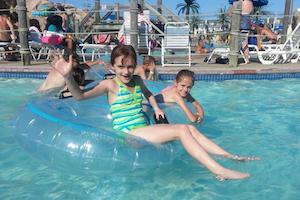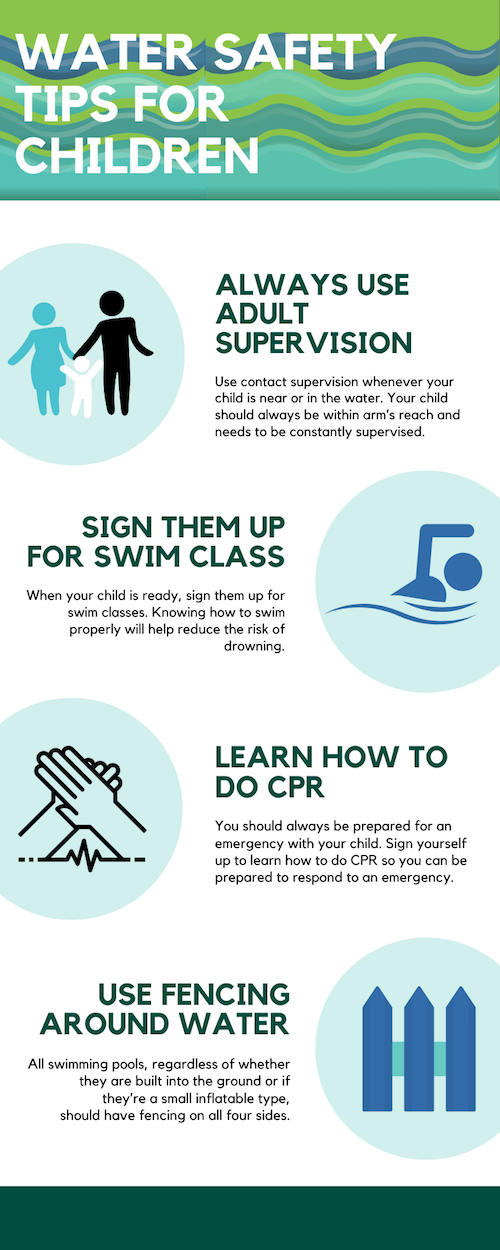Water Safety and Drowning Prevention
 Water safety and drowning prevention are some of the most important things to learn in your child’s first few years of life. Did you know that children in their toddler years are at the highest risk of drowning compared to any other time in their life? It’s a scary thought to think about, but any type of unsupervised access to water can quickly turn into a life or death situation. In fact, drowning is the number one cause of death for children aged 1-4 after birth defects.
Water safety and drowning prevention are some of the most important things to learn in your child’s first few years of life. Did you know that children in their toddler years are at the highest risk of drowning compared to any other time in their life? It’s a scary thought to think about, but any type of unsupervised access to water can quickly turn into a life or death situation. In fact, drowning is the number one cause of death for children aged 1-4 after birth defects.
These hard facts should show you just how imperative is to be prepared for any situation where your child comes into contact with water. Fortunately, there are many ways to prevent your child from experiencing a dangerous situation. Below we have provided some essential tips to help your child stay safe around swimming pools, bathtubs, standing bodies of water, and even bathroom toilets.
What are the Statistics on Drowning for Children?Here’s a short breakdown on what we know so far about the statistics on child drowning incidents:
- 69% of all drownings for children age 4 and below happen during “non-swim times”. This means that most water-related injuries occur when parents would least expect it. It’s impossible for parents to supervise their children every single second, but if you know there is water near or around your house, it’s time to put specific safety barriers in place.
- In a study conducted by the U.S. Consumer Product Safety Commission (CPSC), they found that 70% of children who drowned were not expected or supposed to be around a pool, but most children were found in the water regardless.
- In addition to that study, it was found that 46% of children who drowned were last seen inside the parent’s house.
- 58% of drownings with children age 4 and below took place in a personal pool or spa between the years 2013 to 2015. “Personal” in this context means a pool or spa that was in the child’s own home.
- 27% of drownings of children aged 4 and below took place at a friend, relative, or neighbor’s house.
 For parents of toddlers, you probably already know about how to childproof a house. It involves getting down on the child’s level and identifying any objects that could be harmful to them. Water safety starts in the same manner. You should check inside and around your house for any standing water that could be a hazard for your child. Prevention is key to protecting your child from getting access to water.
For parents of toddlers, you probably already know about how to childproof a house. It involves getting down on the child’s level and identifying any objects that could be harmful to them. Water safety starts in the same manner. You should check inside and around your house for any standing water that could be a hazard for your child. Prevention is key to protecting your child from getting access to water.
Once you’ve identified any and all hazards, the next step is to set up what is known as “layers of protection”. The American Academy of Pediatrics (AAP) has recommended using layers of protection, meaning that every possible access to water should have specific barriers to prevent a dangerous situation.
- Swimming pools
- All swimming pools, regardless of whether they are built into the ground or if they’re a small inflatable type, should have fencing on all four sides.
- The fence needs to be at least 4-feet high.
- There should be no gaps bigger than 4 inches wide underneath the fence or in between slats.
- There should be a gate latch that closes and locks automatically.
- The latch should be high enough that a child cannot reach it, usually at least 54 inches from the ground.
- Regularly check the latch to make sure it works properly and keep the gate locked at all times.
- Use pool and hot tub covers whenever you’re not using them.
- Avoid keeping toys floating in the pool, as it could attract children to get into the water.
- Standing water around the house
- While your child is young, avoid installing things like artificial ponds, fountains, or birdbaths. All of these could put your child in potential danger.
- If you’re doing house renovations such as building a deck or constructing a fence, make sure there is no access to open holes that could be filled with water.
- Bathrooms inside the house
- It may not seem dangerous at first, but bathrooms can still pose a risk to children. Toilets are designed in a shape that makes it hard to drown, which is great, but toddlers are unfortunately at the perfect height to accidentally topple right over into the bowl itself.
- Bathtubs can also be a hazard. You may be thinking that bath time includes constant supervision, but what if your child wanders in alone and accidentally falls into scalding hot water?
- Make sure you keep the bathroom door closed at all times when not in use. Doorknob covers and safety latches can be a great help. It may even be necessary to use locks on toilet seat lids.
- Use contact supervision whenever your child is near or in the water. Your child should always be within arm’s reach and needs to be constantly supervised.
- Always use life jackets whenever you or your child are in or around the water. If your child is not a strong swimmer yet, you can equip them with a life jacket at water parks as well.
- When your child is ready, sign them up for swim classes. Knowing how to swim properly will help reduce the risk of drowning.
- When you take your child to an event, such as a birthday or pool party, make sure you have at least one person supervising and watching children.
- Learn CPR and rescue skills to be prepared to respond if a child needs emergency help.
This article isn’t meant to scare you into never taking your kids around the pool. Many children love playing in the water, and they should be encouraged to have fun. Learning water safety is essential to making sure your child can enjoy themselves in the safest possible way. You should always be prepared to handle any situation your child gets themselves into.

